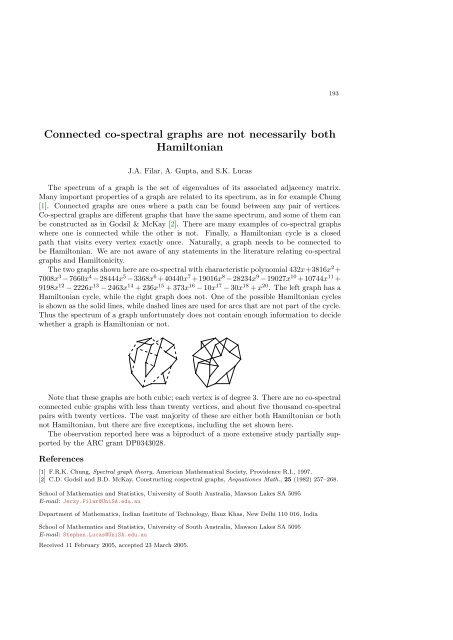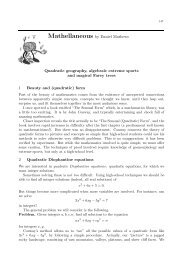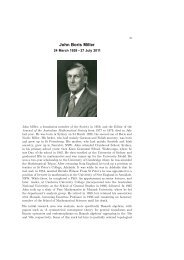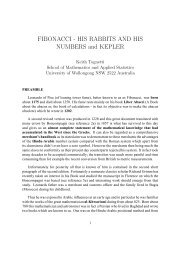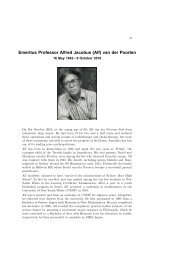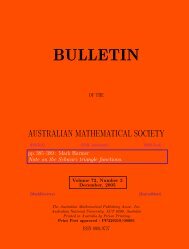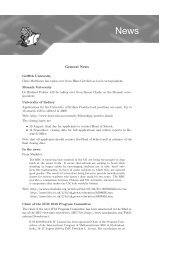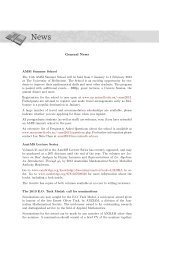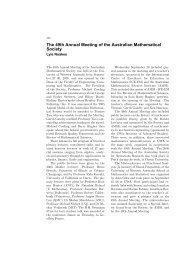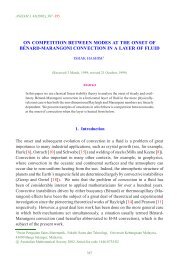Gazette 31 Vol 3 - Australian Mathematical Society
Gazette 31 Vol 3 - Australian Mathematical Society
Gazette 31 Vol 3 - Australian Mathematical Society
You also want an ePaper? Increase the reach of your titles
YUMPU automatically turns print PDFs into web optimized ePapers that Google loves.
Connected co-spectral graphs are not necessarily both<br />
Hamiltonian<br />
J.A. Filar, A. Gupta, and S.K. Lucas<br />
The spectrum of a graph is the set of eigenvalues of its associated adjacency matrix.<br />
Many important properties of a graph are related to its spectrum, as in for example Chung<br />
[1]. Connected graphs are ones where a path can be found between any pair of vertices.<br />
Co-spectral graphs are different graphs that have the same spectrum, and some of them can<br />
be constructed as in Godsil & McKay [2]. There are many examples of co-spectral graphs<br />
where one is connected while the other is not. Finally, a Hamiltonian cycle is a closed<br />
path that visits every vertex exactly once. Naturally, a graph needs to be connected to<br />
be Hamiltonian. We are not aware of any statements in the literature relating co-spectral<br />
graphs and Hamiltonicity.<br />
The two graphs shown here are co-spectral with characteristic polynomial 432x+3816x 2 +<br />
7008x 3 −7660x 4 −28444x 5 −3368x 6 +40440x 7 +19016x 8 −28234x 9 −19027x 10 +10744x 11 +<br />
9198x 12 − 2226x 13 − 2463x 14 + 236x 15 + 373x 16 − 10x 17 − 30x 18 + x 20 . The left graph has a<br />
Hamiltonian cycle, while the right graph does not. One of the possible Hamiltonian cycles<br />
is shown as the solid lines, while dashed lines are used for arcs that are not part of the cycle.<br />
Thus the spectrum of a graph unfortunately does not contain enough information to decide<br />
whether a graph is Hamiltonian or not.<br />
Note that these graphs are both cubic; each vertex is of degree 3. There are no co-spectral<br />
connected cubic graphs with less than twenty vertices, and about five thousand co-spectral<br />
pairs with twenty vertices. The vast majority of these are either both Hamiltonian or both<br />
not Hamiltonian, but there are five exceptions, including the set shown here.<br />
The observation reported here was a biproduct of a more extensive study partially supported<br />
by the ARC grant DP0343028.<br />
References<br />
[1] F.R.K. Chung, Spectral graph theory, American <strong>Mathematical</strong> <strong>Society</strong>, Providence R.I., 1997.<br />
[2] C.D. Godsil and B.D. McKay, Constructing cospectral graphs, Aequationes Math., 25 (1982) 257–268.<br />
School of Mathematics and Statistics, University of South Australia, Mawson Lakes SA 5095<br />
E-mail: Jerzy.Filar@UniSA.edu.au<br />
Department of Mathematics, Indian Institute of Technology, Hauz Khas, New Delhi 110 016, India<br />
School of Mathematics and Statistics, University of South Australia, Mawson Lakes SA 5095<br />
E-mail: Stephen.Lucas@UniSA.edu.au<br />
Received 11 February 2005, accepted 23 March 2005.<br />
193


